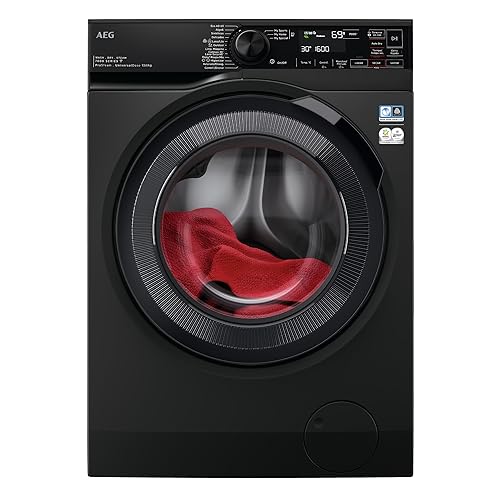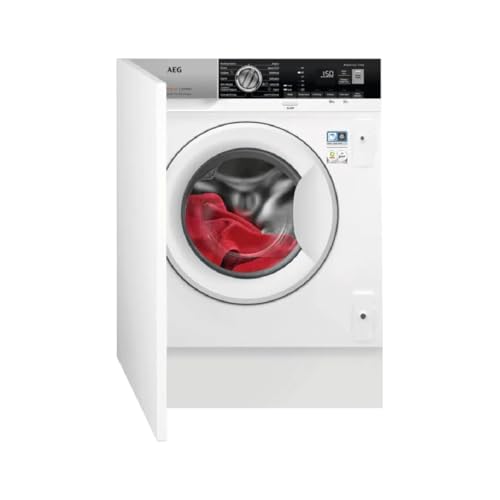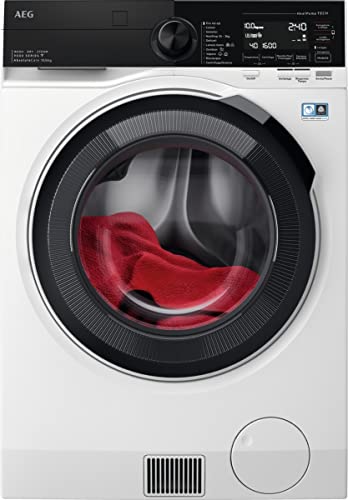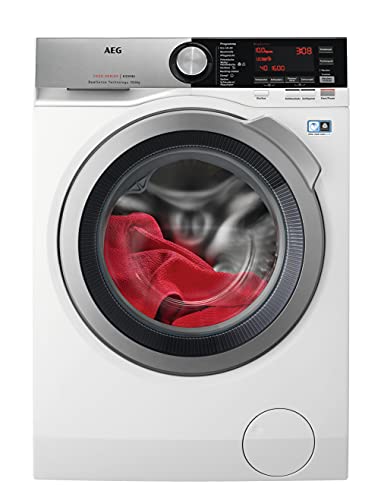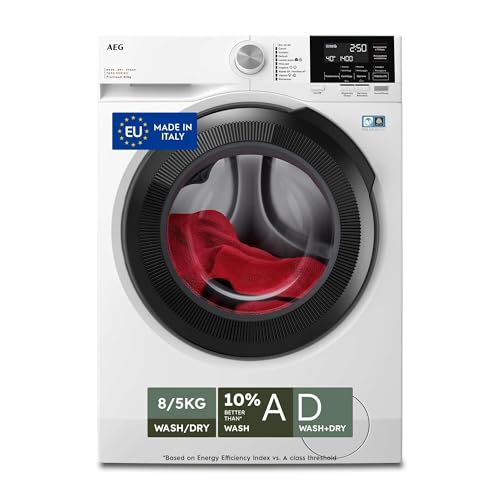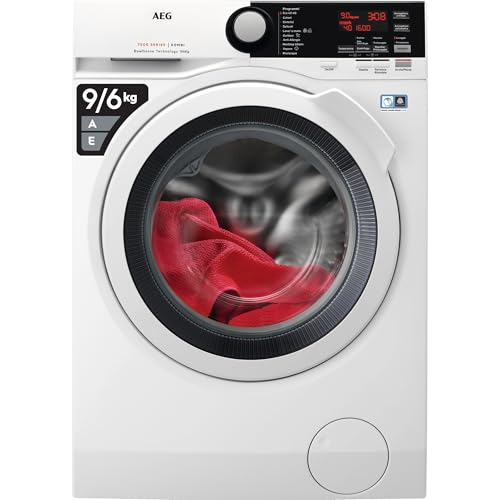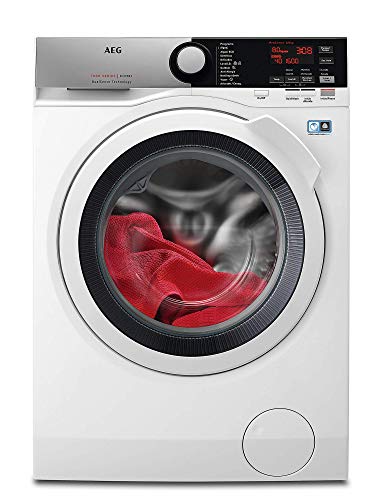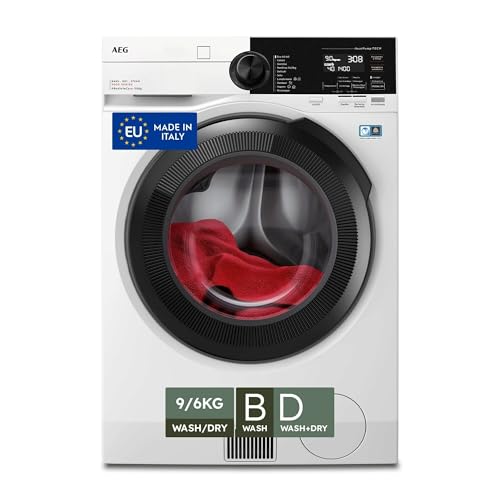Are AEG washer-dryers good?
AEG washer-dryers have an average overall score of 7.4 and rank at position #7 among all washer-dryer brands. Their average user rating is 8, and they hold the #6 spot among the top brands by user rating. 12 brands were considered (brands with fewer than 6 products in the database did not qualify).
The chart below ranks washer-dryer brands based on their overall scores.
[horizontal-chart-33878136557124569]
The best AEG washer-dryers (with the highest overall score) are as follows.
- AEG LWR7185M4B 7000 Series Prosteam (Overall score: 7.52 points)
- AEG LWR7316V6O 7000 Serie Prosteam (Overall score: 8.28 points)
- AEG LWR9816O5X 9000 Series AbsoluteCare (Overall score: 7.87 points)
Note: Products currently available are listed first.
What are the main advantages of AEG washer-dryers?
AEG washer-dryers have the following advantages compared to the market average:
- Inverter motor as standard: All AEG washer-dryers we analyzed include a Silence permanent magnet inverter motor
- Lower energy consumption in washing: AEG washer-dryers use on average 51 kWh per 100 washing cycles (market average is 55 kWh)
- Lower energy consumption in combined cycles: AEG washer-dryers use on average 291 kWh per 100 combined cycles (market average is 318 kWh)
- Larger drum volume: AEG washer-dryers have an average drum volume of 69 L (market average is 60 L)
- Lower water consumption in combined cycles: AEG washer-dryers use on average 67 litres of water per combined cycle (market average is 79 litres)
- Wider spin speed range: Most AEG washer-dryers reach a maximum of 1600 RPM and all models reach a minimum of 400 RPM, which suits delicate clothes
- More functions included: Most AEG washer-dryers include Steam function, Time Save function, Extra Rinse function and Prewash function. Many models also include Anti-stain function, Rinse Hold function and Extra Silent option
- More automatic features and detection systems: Almost all AEG washer-dryers include Laundry detection system (ProSense® or PreciseLoad), Automatic drying (DualSense), Foam control system, Unbalanced load detection, Aqua Stop (Total Aqua Control), Delay start (up to 20 hours), Pause & Add, Selectable drying level and Selectable drying times
- Wi-Fi connectivity in some models: Some AEG washer-dryers include smart features through the My AEG Care app (Favorite function, Voice control, Wash assist, Consumption statistics)
- Special drum design: Most AEG washer-dryers include a ProTex or Care drum, which reduces wear on clothes
What are the main disadvantages of AEG washer-dryers?
AEG washer-dryers have the following disadvantages compared to other brands:
- Higher average price: AEG washer-dryers cost on average £790, which is £240 more than the market average of £550
- Missing advanced features: AEG washer-dryers do not include Automatic load balancing during spin, Pre-mix technology, Automatic drawer cleaning, Water Jets system, Eco Indicator, or an antivibration design
- Limited program options: Only a few AEG washer-dryer models include cycles for shirts, Jeans or Duvets
- Low presence of self-cleaning cycle: Only around 19% of AEG washer-dryers include a Self-cleaning cycle
- Missing less common functions: AEG washer-dryers do not include Water+ function or Power Save mode and only a few models include a Soak function (though these are also rare in other brands)
- No interior light or reversible door: AEG washer-dryers do not include either feature in any model we analyzed
- Heavier build: AEG washer-dryers weigh on average 79 kg, which is 11 kg more than the market average of 68 kg
Who makes AEG washer-dryers?
AEG washer-dryers are produced by Electrolux, a Swedish multinational appliance manufacturer that acquired the AEG household appliance line in 1994. While AEG originated in Germany in 1883, Electrolux now owns the brand and manufactures AEG appliances in its European facilities, primarily in Poland, with some premium models produced in Italy. Despite the shift in manufacturing locations, AEG appliances maintain their German engineering heritage and design principles.
Today, AEG operates as a premium brand within the Electrolux Group, offering a range of household appliances, including washer-dryers. Electrolux, headquartered in Stockholm, Sweden, employs approximately 51,000 people worldwide and is recognized as one of the largest appliance manufacturers globally.
What are the different series of AEG washer-dryers?
AEG washer-dryers come in the following series:
Serie 6000 OneGo: You get the OneGo technology, which runs a single-cycle mode on five programmes with one button press. It includes an inverter motor that rotates the drum quietly without contact, so it cuts noise and energy use. ProSense technology adjusts settings based on the load weight. Steam Refresh reduces wrinkles in 25 minutes. It includes a 20-minute cycle for up to 3 kg and a one-hour NonStop cycle. Aqua Control with Alarm detects leaks. Most models carry a D energy rating. Washing capacity reaches 8 kg, drying 4 kg. You usually find 15 programmes. Prices fall between £590 and £680.
Serie 7000 ProSteam: You move up with PreciseLoad, which improves ProSense by adjusting time, energy, and water to match laundry size. DualSense handles delicates and wool safely. ProSteam freshens clothes with steam between washes and cuts ironing. SpecialCare Wash-to-Dry works with all fabric types and supports outdoor gear care. The Care drum features a smooth pattern and upgraded paddles. Most models have an A energy rating. Washing capacity ranges from 7 kg to 10 kg, drying from 5 kg to 6 kg. They come with 10 to 12 programmes. Prices usually range from £680 to £980. Some models also include the UniversalDose Drawer and Wi-Fi control via the AEG app.
Serie 8000 PowerCare: You add PowerCare technology, which boosts detergent performance with pre-mixing. It includes PowerClean 59', a programme that removes stains in under an hour using the same system. It keeps all features from the 7000 series. Models hold an A energy rating. Washing capacity ranges from 8 kg to 10 kg, drying from 5 kg to 6 kg. Most include 12 programmes. Prices range from £1,020 to £1,150. Some models support PODS® in the UniversalDose Drawer and have Wi-Fi app control.
Serie 9000 SensiDry: You upgrade to SensiDry, which dries at half the heat with a heat pump, so it reduces energy use by 55 % and protects clothes from wear and shrinkage. It swaps the one-hour cycle for a NonStop 3h/3kg cycle, which finishes a 3 kg load from dry to dry in three hours. Some models include PreciseLoad+ that shows under- or overloading in real time to help save water, time, and energy. You still get all 7000 series features. Most models carry an A energy rating. Washing capacity ranges from 9 kg to 10 kg, drying stays at 6 kg. They usually include 10 programmes. Prices range from £1,060 to £1,450. Some units include the UniversalDose Drawer and Wi-Fi connectivity.

What should you consider while choosing the best AEG tumble dryer?
When choosing the best AEG tumble dryer, check the washing and drying capacity first, as it shows how much laundry it can handle in one cycle. Look at the drum volume, which affects how well clothes move during drying. Check the external dimensions to see if the dryer fits in your space. Energy consumption matters too, since lower energy use reduces long-term costs. The motor type affects durability and noise level, so a reliable and quiet motor works better for most homes. You should also check the washing and drying programs, as different fabrics need different settings. Finally, review the extra features that improve performance or user experience.
What is the most common type of AEG washer-dryers?
The most common type of AEG washer-dryers uses condensator technology. Around 75% of AEG washer-dryers use this system. The other 25% are high-end models that use heat pump technology for drying.
Heat pump technology appears in the 9000 Series AbsoluteCare as part of the SensiDry Technology. This system uses low temperatures to dry clothes, so it protects fabrics from shrinkage and wear. You can keep garments in better condition over time.
The chart below illustrates the distribution of drying technologies used in AEG washer-dryers.
[pie-chart-16887316574716039]
What capacities are available for AEG washer-dryers?
AEG washer-dryers come with washing capacities between 7 and 10 kg and drying capacities between 4 and 6 kg. The most common combinations are 9/6 kg (around 31%), 8/5 kg (around 25%) and 10/6 kg (around 25%).
Drum volume in AEG washer-dryers ranges from 52 to 69 L. The average drum size is 69 L, which is 9 L more than the market average of 60 L. You get larger internal space compared to most other washer-dryers.
Depth varies from 54 to 66 cm, so you won't find slim washer-dryers under the AEG brand. If you need a slim model, you should check other brands.
AEG washer-dryers weigh between 68 and 98 kg. The average weight is 79 kg, which is 11 kg more than the average washer-dryer weight of 68 kg.
The following chart displays the capacity distribution for AEG washer-dryers.
[pie-chart-16092915997216006]
How energy-efficient are AEG washer-dryers?
AEG washer-dryers are more energy-efficient than most models on the market. About 75% of them belong to class A for washing energy efficiency, 6% to class B, 13% to class C and 6% to class D. None of them fall into class E. Across the market, only 48% of washer-dryers reach class A, 19% fall into class B, 18% into class C, 12% into class D and 3% into class E. This puts AEG ahead in washing energy efficiency.
For combined energy efficiency (washing and drying in one cycle), AEG washer-dryers rank mostly in class D (44%), followed by class E (31%) and class C (13%). You will not find AEG models in classes A, B or F. In comparison, market data shows less than 1% of washer-dryers belong to class A, 1% to class B, 1% to class C, 41% to class D, 49% to class E and 4% to class F. AEG again scores better overall in this category.
You can expect electricity use between 42 and 69 kWh per 100 washing cycles, with an average of 51 kWh (below the market average of 55 kWh). For 100 combined cycles, AEG machines use between 252 and 376 kWh, with an average of 291 kWh, lower than the market average of 318 kWh.
Water use per washing cycle stays between 42 and 69 litres, averaging 47 litres, which is close to the market average of 48 litres. For combined cycles, AEG machines use between 50 and 75 litres, with an average of 67 litres, which is 12 litres less than the market average of 79 litres.
The chart below highlights the distribution of washing energy efficiency classes among AEG washer-dryers.
[pie-chart-25683825272620795]
What is the spin-drying efficiency of AEG washer-dryers?
The spin-drying efficiency of AEG washer-dryers is usually either class A (about 20%) or class B (about 80%). AEG performs better than the market average, where around 14% belong to class A, 84% to class B and less than 1% to class C.
Spin-drying efficiency class depends heavily on the maximum spin speed. About 94% of the AEG washer-dryers we analyzed can reach 1600 RPM, which puts them among the better-performing models in this category. You can also set all of them to 400 RPM, so you can safely wash delicate clothes that need gentle care.
How loud are AEG washer-dryers?
AEG washer-dryers are about as loud as the average washer-dryer on the market.
- Spin noise level: in AEG washer-dryers range from 70 to 77 dB, with the average being 76 dB, similar to the market average of 75 dB
- Washing noise level: in AEG washer-dryers is usually 51 dB, less than the market average of 54 dB
- Drying noise level: in AEG washer-dryers usually range from 59 to 66 dB, with the average being 60 dB, similar to the market average of 59 dB
Noise emission class in AEG washer-dryers usually ranges from class A to C. Most models (about 81%) fall in class B, followed by class A (13%) and class C (6%). AEG washer-dryers generally have worse noise emission classes than the market average, where 38% belong to class A, 31% to class B, 24% to class C and 7% to class D.
AEG washer-dryers rank at position #7 in the noise level classification (lowest to highest) out of 12 brands.
How many washing & drying programs do AEG washer-dryers offer?
AEG washer-dryers have 10 washing programs (3 programs less than the market average) and 2 drying programs (less than the market average of 4 drying programs).
The most common AEG washing programs are as follows
- Eco 40-60
- Cottons
- Synthetics
- Delicates
- Wool/Handwash
- Outdoor
- Hygiene
- Quick 20 min
- NonStop 60 min
- Steam
The most common AEG drying programs are as follows
- Eco 40-60 + Cupboard dry level
- NonStop 60min
More advanced models include cycles like MixLoad and Anti-Allergy. Only around 19% of AEG washer-dryers include a self-cleaning cycle.
Models with Wi-Fi connectivity that work with My AEG Care app include 18 downloadable programs, as follows
- Sports
- Daily Training
- Feathers
- Football/Rugby
- Ski-Mountaineering
- Running Shoes
- Bedding
- Duvet
- Towels
- Pet Hair
- Baby Clothes
- Denim
- Linen
- Shirts
- Cashmere Steamer
- Easy Iron
- Anti-Allergy Steamer
- Express
Only a few models include Shirt, Jeans or Duvet cycle.
Washing ECO cycle in AEG washer-dryers takes between 200 and 235 minutes (average is 220 minutes, same as market average).
Combined ECO cycle with cupboard drying level takes between 355 and 580 minutes (average is 485 minutes, same as market average).
Which washing/drying functions do AEG washer-dryers have?
AEG washer-dryers usually include the following washing and drying functions.
- Steam function: Reduces wrinkles in blouses and shirts, so ironing is often no longer necessary or only needed minimally
- Time Save function: You can shorten the program duration
- Extra Rinse function
- Prewash function
Many AEG washer-dryers also include the following functions.
- Anti-stain function (around 90%): Adds a stain removal phase to a program to treat soiled or stained laundry with stain remover
- Rinse hold function (around 75%)
- Extra Silent option (around 40%): The intermediate and final spin phases are eliminated and the program ends with water in the drum
We have not found AEG washer-dryers with Water+ function or Power Save mode. Only a few include the Soak function, but this is rare across other brands too.
What features do AEG washer-dryers include?
AEG washer-dryers usually include between 13 and 22 advanced features, with an average of 15 features. This is close to the market average of 14 features.
Almost all AEG washer-dryers include the following features:
- Laundry detection system: ProSense® technology (automatically adjusts the duration of the wash and dry cycle, as well as the water and energy consumption, depending on the amount of clothes you need to wash and dry) or PreciseLoad technology (adapts the cycle duration, as well as water and energy consumption, in proportion to the load volume of the laundry)
- Automatic drying: DualSense Technology (Drum movements, duration and temperature of washing and drying are automatically set according to the type of fabric, from delicate silk to technical garments)
- Foam control system
- Unbalanced load detection
- Acqua Stop: Total Aqua Control System
- Delay start option: for up to 20 hours
- Pause & Add Feature
- Selectable drying level
- Selectable drying times
All models we analyzed use an inverter motor (Silence permanent magnet inverter motor)
Advanced models include the following features:
- Wi-Fi connectivity: Controlled with My AEG Care app, it adds features like Favorite function, Voice control, Wash assist and Consumption statistics
- Favorite function: Lets you save preferred cycles and settings
- Automatic dosing system: AutoDose technology uses sensors to calculate the precise dosage of detergent and fabric softener for each wash
Most AEG washer-dryers include a special drum design, ProTex drum (The gentle jets of water protect and with more holes than a conventional drum, reduce friction and wear even during spinning) or Care drum (Thanks to the new design of the drum, a thin layer of water covers the holes during washing so that the garments can slide delicately on the internal weave)
AEG washer-dryers do not include features like Automatic load balancing during spin, Pre-mix technology, Automatic drawer cleaning, Water Jets system or Eco Indicator. We have not found any mention of antivibration design.
We have not found any models with interior light or reversible door.



